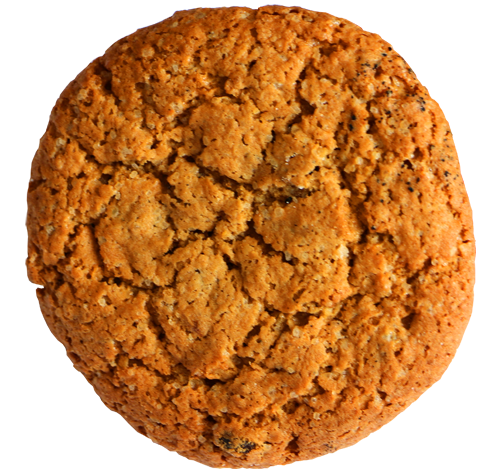
This image has format transparent PNG with resolution 500x475.
You can download this image in best resolution from this page and use it for design and web design.
Cookie PNG with transparent background you can download for free, just click on download button.
A cookie is a baked or cooked food that is typically small, flat and sweet. It usually contains flour, sugar and some type of oil or fat. It may include other ingredients such as raisins, oats, chocolate chips, nuts, etc.
In most English-speaking countries except for the United States, crunchy cookies are called biscuits. Many Canadians also use this term. Chewier biscuits are sometimes called cookies even in the United Kingdom. Some cookies may also be named by their shape, such as date squares or bars.
Biscuit or cookie variants include sandwich biscuits, such as custard creams, Jammie Dodgers, Bourbons and Oreos, with marshmallow or jam filling and sometimes dipped in chocolate or another sweet coating. Cookies are often served with beverages such as milk, coffee or tea and sometimes "dunked", an approach which releases more flavour from confections by dissolving the sugars, while also softening their texture. Factory-made cookies are sold in grocery stores, convenience stores and vending machines. Fresh-baked cookies are sold at bakeries and coffeehouses, with the latter ranging from small business-sized establishments to multinational corporations such as Starbucks.
Cookies are most commonly baked until crisp or just long enough that they remain soft, but some kinds of cookies are not baked at all. Cookies are made in a wide variety of styles, using an array of ingredients including sugars, spices, chocolate, butter, peanut butter, nuts, or dried fruits. The softness of the cookie may depend on how long it is baked.
A general theory of cookies may be formulated this way. Despite its descent from cakes and other sweetened breads, the cookie in almost all its forms has abandoned water as a medium for cohesion. Water in cakes serves to make the base (in the case of cakes called "batter"[8]) as thin as possible, which allows the bubbles – responsible for a cake's fluffiness – to better form. In the cookie, the agent of cohesion has become some form of oil. Oils, whether they be in the form of butter, vegetable oils, or lard, are much more viscous than water and evaporate freely at a much higher temperature than water. Thus a cake made with butter or eggs instead of water is far denser after removal from the oven.
Oils in baked cakes do not behave as baking soda tends to in the finished result. Rather than evaporating and thickening the mixture, they remain, saturating the bubbles of escaped gases from what little water there might have been in the eggs, if added, and the carbon dioxide released by heating the baking powder. This saturation produces the most texturally attractive feature of the cookie, and indeed all fried foods: crispness saturated with a moisture (namely oil) that does not sink into it.
Cookie-like hard wafers have existed for as long as baking is documented, in part because they deal with travel very well, but they were usually not sweet enough to be considered cookies by modern standards.
Cookies appear to have their origins in 7th century AD Persia, shortly after the use of sugar became relatively common in the region. They spread to Europe through the Muslim conquest of Spain. By the 14th century, they were common in all levels of society throughout Europe, from royal cuisine to street vendors.
With global travel becoming widespread at that time, cookies made a natural travel companion, a modernized equivalent of the travel cakes used throughout history. One of the most popular early cookies, which traveled especially well and became known on every continent by similar names, was the jumble, a relatively hard cookie made largely from nuts, sweetener, and water.
Cookies came to America through the Dutch in New Amsterdam in the late 1620s. The Dutch word "koekje" was Anglicized to "cookie" or cooky. The earliest reference to cookies in America is in 1703, when "The Dutch in New York provided...'in 1703...at a funeral 800 cookies...'"
The most common modern cookie, given its style by the creaming of butter and sugar, was not common until the 18th century.
Leah Ettman from Nutrition Action has criticized the high calorie count and fat content of supersized cookies, which are extra large cookies; she cites the Panera Kitchen Sink Cookie, a supersized chocolate chip cookie, which measures 5 1/2 inches in diameter and has 800 calories. For busy people who eat breakfast cookies in the morning, Kate Bratskeir from the Huffington Post recommends lower-sugar cookies filled with "heart-healthy nuts and fiber-rich oats". A book on nutrition by Paul Insel et al notes that "low-fat" or "diet cookies" may have the same number of calories as regular cookies, due to added sugar.
In this clipart you can download free PNG images: Cookie PNG images